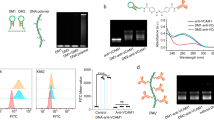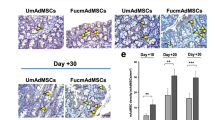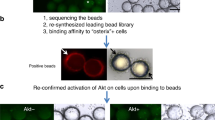Abstract
The capacity to direct migration ('homing') of blood-borne cells to a predetermined anatomic compartment is vital to stem cell–based tissue engineering and other adoptive cellular therapies. Although multipotent mesenchymal stromal cells (MSCs, also termed 'mesenchymal stem cells') hold the potential for curing generalized skeletal diseases, their clinical effectiveness is constrained by the poor osteotropism of infused MSCs (refs. 1–3). Cellular recruitment to bone occurs within specialized marrow vessels that constitutively express vascular E-selectin4,5, a lectin that recognizes sialofucosylated determinants on its various ligands. We show here that human MSCs do not express E-selectin ligands, but express a CD44 glycoform bearing α-2,3-sialyl modifications. Using an α-1,3-fucosyltransferase preparation and enzymatic conditions specifically designed for treating live cells, we converted the native CD44 glycoform on MSCs into hematopoietic cell E-selectin/L-selectin ligand (HCELL)6, which conferred potent E-selectin binding without effects on cell viability or multipotency. Real-time intravital microscopy in immunocompromised (NOD/SCID) mice showed that intravenously infused HCELL+ MSCs infiltrated marrow within hours of infusion, with ensuing rare foci of endosteally localized cells and human osteoid generation. These findings establish that the HCELL glycoform of CD44 confers tropism to bone and unveil a readily translatable roadmap for programming cellular trafficking by chemical engineering of glycans on a distinct membrane glycoprotein.
This is a preview of subscription content, access via your institution
Access options
Subscribe to this journal
Receive 12 print issues and online access
$209.00 per year
only $17.42 per issue
Buy this article
- Purchase on Springer Link
- Instant access to full article PDF
Prices may be subject to local taxes which are calculated during checkout




Similar content being viewed by others
References
Horwitz, E.M. et al. Isolated allogeneic bone marrow–derived mesenchymal cells engraft and stimulate growth in children with osteogenesis imperfecta: implications for cell therapy of bone. Proc. Natl. Acad. Sci. USA 99, 8932–8937 (2002).
Jin-Xiang, F., Xiaofeng, S., Jun-Chuan, Q., Yan, G. & Xue-Guang, Z. Homing efficiency and hematopoietic reconstitution of bone marrow–derived stroma cells expanded by recombinant human macrophage-colony stimulating factor in vitro. Exp. Hematol. 32, 1204–1211 (2004).
Gao, J., Dennis, J.E., Muzic, R.F., Lundberg, M. & Caplan, A.I. The dynamic in vivo distribution of bone marrow–derived mesenchymal stem cells after infusion. Cells Tissues Organs 169, 12–20 (2001).
Sipkins, D.A. et al. In vivo imaging of specialized bone marrow endothelial microdomains for tumour engraftment. Nature 435, 969–973 (2005).
Schweitzer, K.M. et al. Constitutive expression of E-selectin and vascular cell adhesion molecule-1 on endothelial cells of hematopoietic tissues. Am. J. Pathol. 148, 165–175 (1996).
Dimitroff, C.J., Lee, J.Y., Rafii, S., Fuhlbrigge, R.C. & Sackstein, R. CD44 is a major E-selectin ligand on human hematopoietic progenitor cells. J. Cell Biol. 153, 1277–1286 (2001).
Mauney, J.R., Volloch, V. & Kaplan, D.L. Role of adult mesenchymal stem cells in bone tissue engineering applications: current status and future prospects. Tissue Eng. 11, 787–802 (2005).
Mangi, A.A. et al. Mesenchymal stem cells modified with Akt prevent remodeling and restore performance of infarcted hearts. Nat. Med. 9, 1195–1201 (2003).
Pittenger, M.F. & Martin, B.J. Mesenchymal stem cells and their potential as cardiac therapeutics. Circ. Res. 95, 9–20 (2004).
Jiang, Y. et al. Pluripotency of mesenchymal stem cells derived from adult marrow. Nature 418, 41–49 (2002).
Sackstein, R. The lymphocyte homing receptors: gatekeepers of the multistep paradigm. Curr. Opin. Hematol. 12, 444–450 (2005).
Polley, M.J. et al. CD62 and endothelial cell–leukocyte adhesion molecule 1 (ELAM-1) recognize the same carbohydrate ligand, sialyl-Lewis x. Proc. Natl. Acad. Sci. USA 88, 6224–6228 (1991).
Lapidot, T., Dar, A. & Kollet, O. How do stem cells find their way home? Blood 106, 1901–1910 (2005).
Dimitroff, C.J., Lee, J.Y., Fuhlbrigge, R.C. & Sackstein, R. A distinct glycoform of CD44 is an L-selectin ligand on human hematopoietic cells. Proc. Natl. Acad. Sci. USA 97, 13841–13846 (2000).
Sackstein, R. & Dimitroff, C.J. A hematopoietic cell L-selectin ligand that is distinct from PSGL-1 and displays N-glycan–dependent binding activity. Blood 96, 2765–2774 (2000).
Pittenger, M.F. et al. Multilineage potential of adult human mesenchymal stem cells. Science 284, 143–147 (1999).
Kobzdej, M.M., Leppanen, A., Ramachandran, V., Cummings, R.D. & McEver, R.P. Discordant expression of selectin ligands and sialyl Lewis x–related epitopes on murine myeloid cells. Blood 100, 4485–4494 (2002).
Xia, L., McDaniel, J.M., Yago, T., Doeden, A. & McEver, R.P. Surface fucosylation of human cord blood cells augments binding to P-selectin and E-selectin and enhances engraftment in bone marrow. Blood 104, 3091–3096 (2004).
Hidalgo, A. & Frenette, P.S. Enforced fucosylation of neonatal CD34+ cells generates selectin ligands that enhance the initial interactions with microvessels but not homing to bone marrow. Blood 105, 567–575 (2005).
Murray, B.W., Takayama, S., Schultz, J. & Wong, C.H. Mechanism and specificity of human α-1,3-fucosyltransferase V. Biochemistry 35, 11183–11195 (1996).
Schrantz, N. et al. Manganese induces apoptosis of human B cells: caspase-dependent cell death blocked by bcl-2. Cell Death Differ. 6, 445–453 (1999).
de Bruyn, K.M., Rangarajan, S., Reedquist, K.A., Figdor, C.G. & Bos, J.L. The small GTPase Rap1 is required for Mn2+- and antibody-induced LFA-1– and VLA-4–mediated cell adhesion. J. Biol. Chem. 277, 29468–29476 (2002).
Alon, R. et al. The integrin VLA-4 supports tethering and rolling in flow on VCAM-1. J. Cell Biol. 128, 1243–1253 (1995).
Chigaev, A. et al. Real time analysis of the affinity regulation of α4-integrin. The physiologically activated receptor is intermediate in affinity between resting and Mn2+ or antibody activation. J. Biol. Chem. 276, 48670–48678 (2001).
Takamatsu, Y., Simmons, P.J. & Levesque, J.P. Dual control by divalent cations and mitogenic cytokines of α4β1 and α5β1 integrin avidity expressed by human hemopoietic cells. Cell Adhes. Commun. 5, 349–366 (1998).
Mazo, I.B., Quackenbush, E.J., Lowe, J.B. & von Andrian, U.H. Total body irradiation causes profound changes in endothelial traffic molecules for hematopoietic progenitor cell recruitment to bone marrow. Blood 99, 4182–4191 (2002).
Mohler, W., Millard, A.C. & Campagnola, P.J. Second harmonic generation imaging of endogenous structural proteins. Methods 29, 97–109 (2003).
Hauschka, P.V., Lian, J.B. & Gallop, P.M. Direct identification of the calcium-binding amino acid, gamma-carboxyglutamate, in mineralized tissue. Proc. Natl. Acad. Sci. USA 72, 3925–3929 (1975).
Yao, L. et al. Divergent inducible expression of P-selectin and E-selectin in mice and primates. Blood 94, 3820–3828 (1999).
Mocco, J. et al. HuEP5C7 as a humanized monoclonal anti-E/P-selectin neurovascular protective strategy in a blinded placebo-controlled trial of nonhuman primate stroke. Circ. Res. 91, 907–914 (2002).
Acknowledgements
We thank C.A. Knoblauch, L. Liu and J.Y. Lee for assistance in manuscript preparation and for skilled technical support, as well as P.V. Hauschka for helpful discussion of the data. We are grateful to the staff of the Cell Processing Laboratory of the Bone Marrow Transplantation Unit at the Massachusetts General Hospital and the Cell Manipulation Core Facility of Dana Farber Cancer Center for their assistance in procuring the bone marrow harvest filter sets. This effort was supported by National Institutes of Health grants RO1 HL73714 (R.S.), RO1 HL60528 (R.S.) and Massachusetts General Hospital Wellman Center Advanced Microscopy startup fund (C.P.L.). This report is dedicated to the memory of Dr. Harvey R. Colten.
Author information
Authors and Affiliations
Contributions
R.S. conceived the study and reagents, created hybridomas, developed the SACK-1 mAb and the conditions for surface fucosylation of live cells, performed experiments and supervised all research, wrote the manuscript and funded the research; J.S.M., D.W.C. and N.M.D. performed cell culture, biochemical studies and adhesion assays; J.A.S. and C.P.L. performed intravital microscopy and C.P.L. partially funded the research; R.W. synthesized fucosyltransferase.
Corresponding author
Supplementary information
Supplementary Text and Figures
Supplementary Figs. 1–6 and Supplementary Methods (PDF 5151 kb)
Supplementary Movie 1
This video segment shows a marrow sinusoidal endothelial bed within the first minute after injection of FTVI-treated, HCELL-expressing MSCs (bright cells). Note evident rolling interactions and firm adherence of MSCs onto marrow sinusoidal endothelium. (MP4 3000 kb)
Supplementary Movie 2
This video segment shows a marrow sinusoidal endothelial bed withing the first minute after injection of FTVI-Sialidase MSCs. Compared to HCELL+ MSCs shown in Video 1, FTVI-Sialidase MSCs show minimal binding interactions with marrow sinusoidal endothelium. (MP4 3100 kb)
Rights and permissions
About this article
Cite this article
Sackstein, R., Merzaban, J., Cain, D. et al. Ex vivo glycan engineering of CD44 programs human multipotent mesenchymal stromal cell trafficking to bone. Nat Med 14, 181–187 (2008). https://doi.org/10.1038/nm1703
Received:
Accepted:
Published:
Issue Date:
DOI: https://doi.org/10.1038/nm1703
This article is cited by
-
First Clinical Experiences Using Preconditioning Approaches to Improve MSC-Based Therapies
Current Stem Cell Reports (2024)
-
Therapeutic potential of MSCs and MSC-derived extracellular vesicles in immune thrombocytopenia
Stem Cell Research & Therapy (2023)
-
Click-electrochemistry for the rapid labeling of virus, bacteria and cell surfaces
Nature Communications (2023)
-
Loss of Epidermal Homeostasis Underlies the Development of Squamous Cell Carcinoma
Stem Cell Reviews and Reports (2023)
-
Application of Ultrasound to Enhancing Stem Cells Associated Therapies
Stem Cell Reviews and Reports (2023)



